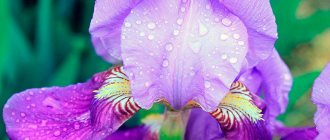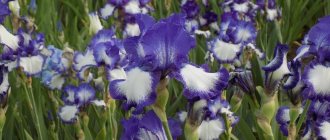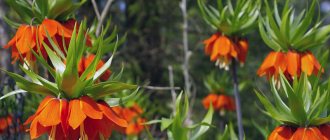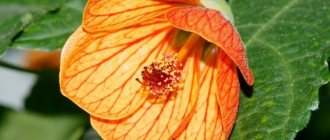Author: Elena N. https://floristics.info/ru/index.php?option=com_contact&view=contact&id=19 Category: Garden plants Published: January 27, 2019Last edits: January 20, 2021
- Growing conditions in the garden
- Bearded irises
Irises are flowers with the richest palette of possible shades, the undisputed dominants of flower beds and bouquets during the fertile time of spring flowing into summer. The main thing that a gardener needs to know about irises is that the flowers of the rainbow goddess Iris love warmth and light. Moisture control is especially important during the budding period (we water regularly and abundantly), the rest of the time we focus on drying out the soil near the roots.
- How to make irises “spread” around the area beautifully?
- How and why should you plant irises “on sand”?
- What are the risks of deep planting of iris?
- How to improve iris bushes that have turned yellow after flowering?
Let's figure it out together.
Planting and caring for irises
- Planting: species plants - by sowing seeds in open ground before winter or after stratifying the seed in the spring. Varietal varieties - by dividing the rhizomes and planting the divisions in the ground every 3-4 years after flowering.
- Flowering: from May to mid-summer.
- Lighting: bright sunlight in the morning.
- Soil: fertile, drained, cultivated to a depth of 20 cm, composition – light or medium, neutral or slightly alkaline.
- Watering: regular, sufficient, during budding – abundant.
- Fertilizing: with mineral complex fertilizers in liquid form before flowering. Do not feed during flowering. Do not use organics.
- Reproduction: seed, vegetative (rhizome division).
- Pests: gladiolus thrips, cutworms, aphids, onion root mites, onion hoverflies, stem nematodes, strawberry and root-knot nematodes, slugs, mole crickets, wireworms, beetles.
- Diseases: bacteriosis, gray rot, fusarium.
Read more about growing irises below.
Iris (lat. Iris) , or Iris , or Cockerel , is a genus of rhizomatous perennials of the Iris family (Iridaceae). Irises grow everywhere and there are about 700 species of various shapes and shades. Translated, iris means “rainbow”. This is what Hippocrates named the flower in honor of Iris, the goddess of the rainbow. The legend says that when Prometheus gave people fire, a rainbow broke out - nature rejoiced so much. The rainbow shimmered all day, evening and night, and when the darkness receded and the sun rose, everyone saw that amazing irises bloomed on the ground - flowers that looked like a rainbow. Florence (translated as “blooming”) received its name from the Romans because the fields around the city were strewn with irises. The iris flower has been in cultivation for more than two thousand years. And they are grown not only as a decoration for gardens, but also as a valuable raw material for the production of essences in the perfume industry.
Conditions for growing bearded irises
Now it’s time to find out how irises are grown in garden plots. For hybrid bearded irises, sunny places, protected from strong winds, are selected. They can tolerate light partial shade from trees. Most varieties have very large flowers, for which gusts of wind and rain are especially dangerous. Therefore, during the period of mass flowering in windy, rainy weather, gartering of flower stalks is mandatory.
Another important condition for growing irises is the presence of light, loamy soil. If the soil in the area is heavy, it needs to be improved by adding sand and peat. Wood ash is added to acidic soils. Before planting, the area should be dug up with a spade and all weeds should be thoroughly removed. Rotted manure is applied to a depth of 20-25 cm, without mixing it with the soil.
Irises are afraid of excess moisture, so they grow best in areas with low groundwater levels. However, during the period of budding and flowering, they show an increased need for water. Good watering at this time helps prolong flowering and creates favorable conditions for pollination. Watering is best done in the evening.
Faded flowers of bearded irises are removed, and the flower stalks are broken off entirely at the end of flowering. In late autumn, the leaves are shortened to 10 cm. Plants are covered with a small layer of mulch for the winter. Frost-unresistant varieties are covered more thoroughly. In the spring, after the snow has melted, carefully stir up the compacted winter shelter. It is completely removed in early or mid-April, depending on weather conditions. Bearded irises, despite their southern origin, tolerate spring frosts quite well compared to other perennials with temperatures dropping to -5...-7 °C.
Botanical description
Irises are rhizomatous plants. Cord-like or thread-like roots grow on the rhizome. Peduncles (one or more) are annual. The leaves are flat, xiphoid, thin, two-rowed, sometimes linear, with a waxy coating. They are collected in fan-like bunches at the base of the peduncle; there are almost no stem leaves. Irises have solitary flowers, sometimes in small inflorescences, large, often fragrant, distinguished by an intricate, elegant shape and can be painted in a wide variety of colors and their combinations. The flower has six petals (actually these are perianth lobes). The three outer lobes are slightly turned downwards, and they usually differ in color from the upper lobes, which, fused at the bottom, form a tube. Irises bloom from May to July, two or three flowers bloom simultaneously for one to five days. The fruit of the iris is a three-lobed capsule.
- Apple tree: growing in the garden, types and varieties
general information
Irises are called differently in different regions - irises, cockerels, magpie flowers or braids. They are notable for the bizarre shape of their petals, painted in all sorts of colors of the rainbow. The leaves are long and flat, sword-shaped and with a waxy surface.
Iris flowers are large and fragrant, with six petals: three turned down and three more fused and raised up. They grow solitarily, but occasionally larger inflorescences are found. Irises are quite capricious to care for, but in return the flowerbed will delight you with unprecedented beauty from May to July.
Photo: sad-fialok.ru
Features of cultivation
Many lovers refuse to grow irises, believing that it is a very difficult process. In fact, growing irises is not at all tedious and not as labor-intensive as it seems. You just need to know some of the subtleties that distinguish caring for these beautiful flowers.
Firstly, the peculiarity of irises is that their rhizomes grow horizontally and are often exposed when reaching the surface. Therefore, in winter, irises must be sprinkled with soil and peat so that they do not freeze. In spring, this covering is carefully removed.
Secondly, irises love to move, and in one year they can shift their location to the side by several centimeters. To make the rows look straighter, irises should be planted with a fan of leaves along, rather than across, the row.
How to plant lilies correctly, how to care for them after
Thirdly, bearded iris should be planted on sand: sand is poured into the bottom of the hole and the iris root is spread over it. If planted deeply, the iris will either disappear or not bloom.
Fourthly, do not feed irises with organic fertilizers, they do not like them. The best type of fertilizing is mineral fertilizers in liquid form.
Pest and disease control
Irises are not too painful and most often suffer from root rot or bacteriosis. Tubers accumulate water, and in combination with waterlogged soil, frost or excess organic fertilizers, the result will not be long in coming. Therefore, inspect the flower bed regularly, especially after winter, to immediately remove damaged tubers.
Of the fungal diseases, rhizoctonia and fusarium most often develop, especially in cold, rainy spring. For prevention, do not forget about seasonal spraying with fungicides and be sure to treat the tubers before planting.
Thrips, aphids, iris flies and cutworm butterflies love to eat irises, and large tubers attract wireworms and beetle larvae. Nematodes cause many diseases, complications and developmental delays. Be sure to dig up the soil at the beginning of the season, apply antiseptics and use insecticides.
Photo: pxhere.com
Planting irises
When and where to plant
It is generally accepted that irises should be divided and replanted immediately after flowering to give them time to set before winter. But if autumn is warm and long in your area, you don’t have to rush into replanting. In fact, irises can be planted in spring, autumn, and summer after flowering. The main thing is not to forget to replant irises every 3-4 years, and Siberian irises - at least once every ten years, otherwise they degenerate, grow and stop blooming.
In the photo: Growing irises in a flower bed
Bearded irises should be planted on well-lit slopes or hills in the first half of the day, protected from drafts, so that there is an outflow of melt water and good drainage. Swamp and Siberian irises, on the contrary, love moist soil. But both irises love rich soil, and if the soil on your site does not meet this requirement, add rich garden soil or compost to the soil in the spring before planting, and fertilize it with potassium-phosphorus fertilizers.
If the soil is acidic, add dolomite flour, chalk or wood ash. If the area is loamy, add peat and sand; if, on the contrary, the area is sandy, add clay soil. To disinfect the area before planting, spray the area with a fungicide and treat it with herbicides against possible weeds.
Do not use manure to fertilize the area.
Spring planting
Planting and caring for irises requires some knowledge, but not as much effort as it seems to novice gardeners. Planting material, if it has been stored over the winter or was purchased in a store, before planting it is better to treat it with growth stimulants such as Ecogel or Zircon. Long roots must be carefully trimmed, rotten areas must be removed, and the root must be kept in a solution of potassium permanganate for 20 minutes for disinfection.
Planting irises is done as follows: pour a mound of sand into a shallow hole, lay the bearded iris rhizome horizontally on top, straighten the roots, cover it with soil so that the upper part of the rhizome remains above the level, and water well. If you bury the entire rhizome, you can cause it to rot. Beardless irises, on the contrary, need to be buried a few centimeters and, in addition, mulched with fallen pine needles or peat to retain moisture. The distance between the irises should be at least half a meter.
In the photo: How to properly plant irises in open ground
Planting in autumn
Irises are planted in the spring in the same way as in the fall, or rather in late summer, namely after flowering. This usually occurs from August to the end of September, although the earlier you plant, seed or transplant irises, the more confident that they will take root. You need to dig up an iris bush with a pitchfork, divide it into annual links with a leaf blade, carefully shorten the cord-like roots, cut out damaged or rotten areas, disinfect it for a couple of hours in a dark pink solution of potassium permanganate, then dry it in the sun for 4-5 hours. Planting irises is carried out in a way already known to you. The distance between low-growing irises is 15 cm, medium-growing ones are 20 cm, tall ones are 50 cm.
In the photo: Planting irises in a flowerbed
Why don't irises bloom?
Irises are beautiful flowers, but sometimes they do not bloom or stop blooming. Thanks to their popularity, irises have received a huge number of varieties, differing not only in size and color of flowers, but in height and shape. Unfortunately, although iris flowers are extremely beautiful and decorative, sometimes they may not appear at all, which causes us great disappointment. Below are the main reasons why irises don't have flowers.
Planting depth
One of the reasons for this situation is improper planting of rhizomes. Plants have very specific requirements in this regard; if you do not take them into account, irises will not bloom. To wait for beautiful flowers, you need to plant the rhizomes shallowly, barely covering them with soil (if planted too deep, the flowers will not bloom).
Instead of a hole, you need to prepare a small mound of soil, on which the rhizome and roots are placed (the roots cannot be rolled up), and then lightly sprinkled with soil, covering only the roots and sides of the rhizomes.
Features of planting and root division
- The old school of iris growers emphasizes how to plant irises correctly. The rhizome should be placed in the ground facing south so that it is not shaded by wide leaves and can become warm.
- Before planting rhizomes, you need to shorten the leaves growing from them, which will reduce water evaporation and drying of the roots.
- Plants should not be planted and divided immediately after flowering - at this time, irises form flower buds for the next season.
- When digging up rhizomes, it is easy to damage the buds, losing next year's flowers, so when rejuvenating irises, it is better to wait until the end of summer (second half of August - September). Flower buds are also damaged by gardening tools when weeding plants carelessly.
Soil moisture and quality
When planting irises, you should remember that the flowers are sensitive to stagnant water, excessive humidity, and flooding. If you plant them in wet, cold soil, the plants will rot rather than bloom. This does not mean that plants should grow on barren sands; they like fertile, permeable, slightly moist soils with humus, sunny places.
When irises stop blooming
A noticeable weakening or complete absence of flowering may be due to the age of the bushes. Irises are perennial plants, but short-lived, so after a few years (4-5) they stop producing flower shoots and lose their decorative value. The bushes “go bald” in the middle, the plants become susceptible to disease, drying out, and rotting.
To continue to enjoy wonderful flowers, you need to rejuvenate them by choosing for further cultivation strong, young, healthy, strong rhizomes with several distinct buds.
Caring for irises
Growing conditions in the garden
Love of warmth and light is the main feature of irises. As for watering, it is important to strictly monitor the amount of moisture the plants receive during the budding phase. At this time, watering should be regular and sufficient. In general, you need to water irises only when the soil near the roots becomes very dry.
- Photos of irezine species
Karbofos - from planting to digging
As for fertilizing, in most cases it will be sufficient to fertilize the soil during the spring preparation of the site. But if you think that the plants need nutrition, then it is appropriate in the form of a solution of phosphorus-potassium fertilizers applied at the root during growth, but it is strictly forbidden to fertilize irises during flowering.
In the photo: Iris rhizome
You will have to fight weeds throughout the growing season. Weeding is done by hand, since the horizontally developing root system of irises is very close to the surface, and you can accidentally disturb it by working with a hoe. Occasionally, you still need to loosen the soil, but you need to do this very carefully, trying not to damage the roots. And one more thing: do not be lazy to remove wilted flowers, otherwise they can become a breeding ground for pests.
Karbofos for lush flowering
Diseases and pests
The more graceful and variegated the variety of iris in the flowerbed, the higher the likelihood of it being affected by diseases and pests. The main condition for the health of your plants is compliance with all the rules of agricultural technology of the species. In addition, it is necessary to monitor the “well-being” of irises throughout the growing season in order to see the problem in time and be able to eliminate it.
If the plant is affected by fusarium or another type of rot, the delay in death is similar: you must immediately remove and destroy the diseased specimen and be sure to spill the rest of the irises along the roots and under the root with a two percent solution of Fundazol. Use this drug as a preventive treatment of rhizomes before planting, then the risk of disease will be reduced.
As a preventive measure against spots of all types, spraying irises with a one percent solution of Bordeaux mixture is used.
In the photo: Iris is rotting
The most common pest that affects irises is cutworm, which eats away the base of flower stalks, causing them to turn yellow and die. To avoid this problem, at the beginning of the growing season you need to spray the irises with a ten percent solution of karbofos twice at weekly intervals.
They attack irises and gladiolus thrips, which disrupt photosynthesis in the leaves of the plants, they become brown and dry out. Iris buds affected by thrips become ugly and discolored. The risk of thrips infection is especially high during dry summers. The problem can be eliminated with the help of Karbofos, as in the case of the scoop, or by spraying the plants with a strained ten-day infusion of 400 g of shag with the addition of 40 g of grated laundry soap.
Slugs can become pests of irises. To get rid of them, place wet rags or burdock leaves between the iris bushes, which the slugs use as shelter, then collect them together with the slugs and destroy them. There is another way to combat slugs: in dry weather, early in the morning or evening, scatter granular metaldehyde over the area at the rate of 30-40 g per 10 m2.
Part 2. Nuances of cultivation
Iris includes 800 species. Some of them are successfully cultivated all over the world. All varieties are different. For example, Dutch iris is a bulbous plant, while Siberian and bearded irises are rhizomatous plants. Planting and care of all varieties have their own characteristics.
Siberian
This variety is considered the most hardy. It has a rhizome system. Growing this crop is possible not only in central Russia, but also in the northern regions.
Nuances of caring for Siberian irises:
- Plenty of sunshine and warmth. Sunlight is especially important when growing in northern regions;
- Permeable soil that does not retain moisture with a neutral or slightly acidic reaction;
- Twice feeding: at the beginning of spring and during the formation of buds;
- Trimming old leaves and faded flower stalks.
The planting of Siberian irises is different. Their roots need to be buried approximately 7 cm into the soil.
Japanese or xiphoid
Japanese irises
Japanese irises are heat-loving and fairly unpretentious plants. The rules for planting and caring for this plant generally do not differ from the agricultural practices of other varieties.
Care for the xiphoid iris includes:
- Adequate sunlight;
- Apply fertilizing two or three times a year. It is recommended to give preference to mineral fertilizer, but organic substances should not be neglected;
- Shelter for the winter is mandatory when growing crops in central Russia or in the northern regions;
- Autumn pruning of leaves.
When planting, the root system must be buried approximately 6 cm into the ground so that the rhizome does not freeze in winter.
Mesh
These are bulbous crops. It is advisable to plant them at the beginning of the autumn period. The bulb is deepened according to the general rules for planting bulbous plants.
Features of caring for reticulated iris:
- Nutritious, permeable and light soil;
- Adequate sunlight;
- Proper watering. There should be no stagnation of water in the soil. Watering is required only in dry weather, and during the budding period the soil should always be moistened;
- Mineral fertilizers and compost are used as top dressing.
Dutch
Dutch iris is a bulbous plant. Their bulbs are small in size. It is recommended to plant them at the end of summer, since the bulbs do not tolerate autumn cold snaps.
Caring for bulbous Dutch iris involves:
- Excess moisture in the soil is fraught with diseases, including the death of the plant; watering is required only during periods of prolonged drought;
- Plenty of light;
- It is recommended to dig up the bulbs after flowering.
Swamp
The marsh (water) iris differs from other species; it has its own characteristics of care. This type is ideal for decorative ponds in garden plots. It is recommended to plant the variety in early autumn or at the very end of summer. At the same time, it is recommended to choose moist, or even flooded, areas for planting. This is the most common wild iris.
Nuances of caring for swamp iris:
- Do not allow the soil to dry out;
- Adequate sunlight;
- Wind protection;
- Application of fertilizing, including in the fall before preparing for winter;
- Autumn pruning of leaves.
There is no need to cover marsh iris; they are frost-resistant.
Bearded
Popular variety of bearded iris Gypsy
This is one of the most popular and beautiful varieties of culture. This iris should be planted in the summer, preferably in the middle of the summer. It is important to choose the right site for planting. The soil must be permeable, since the plant does not tolerate stagnant moisture. The soil reaction is alkaline or slightly acidic. Heavy and clayey soils are not suitable for bearded iris.
Bearded iris care includes:
- Watering only in dry weather;
- Plenty of light;
- Trimming old leaves at the end of summer;
- Shelter for the winter. It is especially necessary for tall varieties;
- Fertilizing three times a year: in spring (nitrogen fertilizers), during budding (potassium-phosphorus fertilizers), in autumn (potassium-phosphorus fertilizers). Bearded iris also responds well to the addition of humus and compost.
Germanic
One of gardeners' favorite flowers is the German iris, planting and caring for which is similar to the bearded iris. It can be planted from spring to autumn. The soil must be permeable, slightly acidic or neutral. Fertilizing - three times a year, watering only during drought. The video below shows planting German iris in pots, the video is not in Russian, but everything is clear.
short
Low-growing (dwarf, border) species are a form of bearded irises. They differ only in the difference in height. Their height does not exceed 40 cm, but on average they grow no higher than 20 cm. Border (low-growing) irises are perfect for framing flower beds and paths, for mixborders, and edgings; planting and caring for them is simple.
Features of planting and caring for dwarf irises:
- Plants should be planted in a sunny place, in nutritious, neutral or slightly acidic soil without stagnant moisture;
- When planting, you must remember that the root system of such an iris should be close to the surface of the soil, there is no need to deepen it;
- Fertilizing three times a year.
Thin-leaved
This is an easy-to-care crop. It is resistant to drought and frost.
Features of planting and caring for thin-leaved iris:
- The plant only needs watering during periods of drought;
- Planting from spring to autumn;
- Application of fertilizing according to the standard scheme;
- Plenty of sunlight.
If you received bouquets of irises as a gift or cut them yourself to decorate your apartment, you will need to follow several rules so that the plants last longer in the vase. Caring for cut irises includes:
- Daily replacement of water in the vase;
- Periodically wash the vase in hot water;
- Spraying plants;
- Keep in a cool place;
- Remoteness from radiators and heaters.
Irises after flowering
If you are not going to plant your irises this year, then it is best to cut off the flower stalks after flowering. If the leaves begin to turn yellow, you can cut off the yellowness, making the tip of the leaf semicircular - it looks very pretty, and your iris will still decorate the flowerbed, and its rhizome will gain nutrients for growth and flowering next year.
If the autumn is warm, irises may bloom a second time.
When the leaves finally wither, cut them at a height of 10-15 cm and burn them to destroy possible pest eggs or pathogens.
In the photo: Reproduction of irises by division
Before the onset of cold weather, sprinkle the bare roots of irises with soil, mulch the area with a layer of sand or peat 8-10 cm thick. If there is a possibility of severe or prolonged frosts, cover the area with dry leaves or spruce branches. If the winter is snowy, the irises will not need shelter.
Selection of planting material
When purchasing iris planting material, you should carefully look at:
- firstly, on the size of the rhizome itself, because the larger it is, the better the plant takes root, grows faster and blooms earlier;
- secondly, are the rhizomes healthy, are there any signs of disease on them;
- thirdly, whether the vegetative buds are well formed, but at the same time there should be no active vegetative growth;
- fourthly, the rhizomes must be dry, but not overdried.
If you buy planting material on the market, then the surest way to purchase exactly the variety you want is to try to buy a tuber along with a peduncle.
And if you already have irises growing and they have reached the age of 4-5 years, then planting material for further propagation of irises can be obtained by dividing the rhizomes of these plants.
Over time, irises grow in width and the center of the bush gradually disappears. Therefore, it is advisable to renew the plantings every five years.
Storing irises
If you bought or dug up bearded iris rhizomes in the fall and want to store them until spring, the best place to store them is in a cool, dry room. Place the well-dried roots in a box and take them out to the balcony or loggia. You just need to first wrap each root in paper, cloth, or sprinkle them in a box with dry sawdust or dry peat.
In the photo: Preparing irises for storage
All other types of irises are moisture-loving, so the best way to preserve the iris root until spring is to plant it in a flowerpot, first cutting off the long roots, disinfecting it in a weak solution of potassium permanganate and drying it after that. The root is not immersed deeply in the ground, lightly sprinkled with earth on top. In the spring, the sprouted root, together with a lump of earth, is planted in the ground.
- Mesembryanthemum: growing from seeds and care, types
Iris in landscape design
Very often, iris is used when planting in parks, squares, and when decorating areas in landscape design. The huge variety of varieties and species, as well as the high stability of the plant itself, allow the wider use of this crop for landscaping. Curtains of different varieties of irises look great on a lawn carpet.
“Fields” of irises of different colors look very beautiful
Mono-plantings of iris crops decorate urban areas and do not require serious care. This crop has the advantage of being planted for many years in one place and maintaining a decorative appearance.
Types and varieties
Bearded irises
Based on the shape of the flower, botanists divide root irises into bearded and non-bearded. Bearded irises, so called because of the shaggy hairs on the petals, have their own classification (tall, medium-sized, border, standard medium-sized, small-flowered medium-sized, linking medium-sized, standard dwarf, miniature dwarf, table, arylbred, aryl and arylbred, non-aryl-like arylbred, aryl and aryl-like arylbreds). But this classification is for scientists; for amateur gardeners, they are all just bearded irises of different sizes.
In the photo: Bearded irises
In the photo: Bearded irises
In the photo: Bearded irises
German iris (Iris germanica)
In cultivation, there are hundreds of varieties of tall bearded iris, which also exists under the name German iris. German iris is the most common type of bearded iris. Here are some popular varieties that will decorate any garden:
- Baltic Sea – highly ruffled deep blue irises with blue beards;
- Bewilderbest - ruffled cream-burgundy-red with stripes and touches of yellow and white;
- Acoma - sky blue-ivory with lavender border, very popular with Americans.
German iris (Iris germanica)
German iris (Iris germanica)
Non-bearded irises
The general name is conditional and includes the following species: Siberian iris, Japanese iris, Iris spuria, Louisiana iris, Californian iris, marsh iris and other irises (specific and interspecific). We will tell you about the most popular species in our latitudes:
Siberian iris (Iris sibirica)
Whose natural color varies from blue to dark purple, although today about 1000 varieties with different colors have already been bred, for example:
- white irises Snow Queen ;
- Imperial Opal 80 cm high, pink lavender color, flowers up to 10 cm in diameter;
- yellow iris with white border Batts and Sugar .
There is only one drawback - Siberian iris lacks aroma.
In the photo: Siberian iris (Iris sibirica)
In the photo: Siberian iris (Iris sibirica)
In the photo: Siberian iris (Iris sibirica)
Japanese iris (Iris japonica)
Aka xiphoid iris, aka Kaempfler's iris with large orchid-like flowers up to 25 cm in diameter, odorless. Japanese breeders have developed a multi-petaled and double-petalled garden form of Japanese iris called hana-shobu. Unfortunately, this species is not frost-hardy, so flower growers are recommended varieties bred specifically for our latitudes:
- Nessa-No-Mai – purple with white, flowers – up to 23 cm in diameter;
- Solveig – delicate light lilac iris;
- Vasily Alferov ink-colored non-double iris;
In the photo: Japanese iris (Iris japonica)
In the photo: Japanese iris (Iris japonica)
In the photo: Japanese iris (Iris japonica)
Iris spuria
Very elegant, similar to the bulbous iris xyphium, but much larger. In addition, Iris spuria is frost-resistant and drought-resistant. Among the most beautiful:
- Lemon Touch – lace yellow-lemon with a darker gold signal, high – 1 m;
- Transfiguration - the same tall dark purple to blue-violet iris with a bronze signal;
- Stella Irene – purple-black with a small gold signal, height 90 cm.
In the photo: Iris spuria
In the photo: Iris spuria
In the photo: Iris spuria
Swamp iris (Iris pseudacorus)
Or false calamus iris. This species stands apart because it is very different from other species in that it grows only in moist soil. In nature it has flowers of yellow shades; in culture, marsh iris is used to decorate artificial reservoirs. Popular varieties
- Golden Queen with yellow flowers,
- Flore Pleno – terry variety,
- Umkirch – pink flowers.
In the photo: Swamp iris (Iris pseudacorus)
In the photo: Swamp iris (Iris pseudacorus)
In the photo: Swamp iris (Iris pseudacorus)
Based on color, iris varieties are divided into:
- single-color (same color of all iris lobes);
- two-tone (lower and upper lobes of different shades of the same color);
- two-color (lower lobes of one color, upper lobes of another);
- variegata (lower lobes red-brown, upper lobes yellow);
- amena (top white);
- bordered or plicata (contrasting border either on the lower lobes or on all);
- iridescent (smooth transition from one shade to another).
Hello, dear readers!
Let's continue the conversation about irises - the amazing flowers of our garden. Previously, we talked about their history and classification, and now it’s time to learn about planting irises and caring for them.
In this article we will talk about bearded irises, since they are very popular among summer residents.
When they bloom, they no longer have rivals and there is not a single one among them that is similar, and each of them has an amazing aroma.
In most regions of our country they grow well, but this is subject to all the nuances of agricultural technology.
Without knowing what irises like and don’t like, you can wait a long time to see when they will bloom.
Popular colors
Tradescantia - types of hanging plants Anderson, Zebrina and others
Numerous varieties of irises are divided by color: single-color (Self), two-tone (Bittone), two-color (Dicolor).
For your information! When the bud's upper petals are lilac, the lower ones are purple or light blue, and the foils are darker, they are called Neglecta.
Blue
Heavenly flowers stand out in any flower bed and front garden. The petals of the bud are painted in various shades of blue. They look harmonious next to blue and purple flowers. They look spectacular in a bouquet. Popular varieties of this color include:
- Honky Tonk Blues;
- Dusky Challenger;
- Victoria Falls;
- Sapphire Dawn;
- Baltic Sea.
The German iris has many representatives of this color.
Soft blue flower, Victoria Falls variety
For your information! The blue color of the iris inspired the designers to create the Milavitsa line of lingerie.
Purple
Purple colored killer whales are combined with delicate flowers of white and pink tones. The best representatives of this species:
- About Town;
- Autumn Jester;
- Explosive character;
- Lady Vanessa;
- Smile;
- Night owl;
- Cupid-Father.
Night owl
White
A white iris flower in a flowerbed looks elegant. Most varieties belong to the bearded group. Some species have small inclusions on the petals near the core of a bright tone. Thanks to selection, plants with a unique appearance have appeared. You should choose from the following varieties:
- White Nights;
- Bianca;
- Immortality;
- Snowflake Lacey;
- Lady Snowflake.
Snowy Lacy
Black
For gothic lovers, breeders have developed new varieties of dark and black shades. Among them:
- Before the Storm
- Night Game;
- Black dragon.
Black beauties are light-loving plants. The ideal place for planting them is a well-lit area that is protected from stagnant water and winds.
Before the Storm variety











